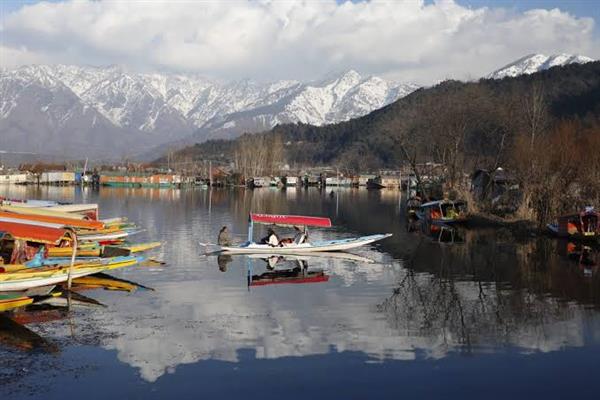By: Surinder Singh Oberoi
In the idyllic landscapes of Tral, south Kashmir, a hidden gem from ancient times languishes in a treasure trove of history and culture the Gufkral Caves, nestled within the old-fashioned Gufkral village. It also witnesses the passage of time and the enduring legacy of eighteen potter families spanning generations.
It is a saga of resilience and heritage now overshadowed by neglect, slowly crumbling as we endeavour to revive the ancient arts and crafts. The village’s cultural and historical significance deserves to be resurrected from oblivion and placed prominently on the tourist map, with the support of historians adorned with spot windows of attraction, and showcases.
These fading caves have not merely provided shelter for generations of potters; they have cradled a piece of history dating back to the mists of time, potentially tracing their origins to the ancient epochs of 2000-3000 BCE.
The very name “Gufkral,” where “Guf” means caves and “Kral” means potters, pays homage to these sacred caverns where artisans have toiled and artists have thrived.
A fresh perspective is required on how to exhibit this site to attract both tourists and locals. Visitors should not only tour the village but also have the opportunity to purchase decorative pottery pieces like pottery dinner sets, lamp shades, health-friendly daily use utensils, and other decorative items, turning their visit into an educational and enjoyable experience. Otherwise, the archaeological significance, currently facing neglect and indifference, will soon teeter on the brink of oblivion.
The story of the Gufkral Caves unfolds—a narrative of resilience, craftsmanship, and the urgent need for preservation. These caves echo centuries of history, yet despite their undeniable archaeological importance, they remain concealed in the shadows, overlooked by authorities and tourism agencies.
Harbaksh Singh, a member of the District Development Committee of Tral, is bewildered by this cultural neglect. He envisions a renaissance for these eighteen potter families and aspires to transform Gufkral into a hub of Kashmiri pottery—not just as a source of income but as a celebrated art form that entices both locals and tourists alike.
Dr Harbakash notes, “In a time when the current generation and cautious leaders are working to re-energise and re-establish the cottage industry, keeping in view the climate change. these eighteen families of potters in Kashmir, despite their modest number, deserve support and guidance to rekindle the allure of Kashmiri pottery. It could become a sought-after treasure for both locals and visitors alike.”
What is greatly needed is vision and training for these potters, elevating this village into a hub of pottery craftsmanship that draws admirers from far and wide. Dr. Harbakash vows to approach the Lieutenant Governor of J&K to advocate for the establishment of the village as a thriving centre of local art, envisioning an annual pottery craft fair to inspire excellence.
The internet search unfurls the historical tapestry woven within Gufkral through the excavation efforts led by an ASI team in 1981, under the stewardship of A K Sharma. Their discoveries revealed a history spanning from the Aceramic Neolithic to the Megalithic periods. Some historians even speculate that Gufkral may have been the initial settlement centuries ago of early Neolithic inhabitants in the valley.
The Gufkral caves, serving as the lifeblood of these potters, now face an uncertain fate. This artistry is not merely a livelihood but also a cherished part of their identity and heritage—a legacy that has endured for centuries.
The tragedy unfolds as the younger generation of potters grapples with dwindling demand and contemplates abandoning their ancestral craft. This unique cultural enclave, known only to locals, yearns for the spotlight, for its essence is slowly eroding with each passing day.
The government bears the solemn duty to safeguard this invaluable heritage, lest it fades into the annals of history. The encroachment of modernity continues to encircle these caves, threatening the excavated sites that still hold secrets waiting to be unearthed, with one cave stretching 30 meters in length. Yet, the potters beseech that conservation should not come at the cost of their homes.
Their identity is linked to these caves, and it is time for the government to acknowledge this plight and train them to both preserve the caves as guardians and nurture their art. Conflicting interests have held back meaningful preservation efforts, and the limited awareness among the public further exacerbates this dire situation, leaving these ancient treasures to languish as unproductive terrain.
The conservation of Gufkral’s heritage, when approached with the welfare of its potters in mind, can breathe new life into this centuries-old art form. It can instill a sense of identity and belonging, preserving a tangible link to their ancestors and forgotten history.
Let these caves become an integral part of the potters’ daily lives. They need to be trained, guided, and supported on how to make it a world-class attraction for tourists, preserving the heritage and culture while showcasing the local inheritance, all while keeping the modern concrete jungle at bay.
The government must support this village to become a model and a landmark, allowing Kashmir pottery to be known and recognized for its craftsmanship, with the responsibility to preserve and care for the forgotten caves. It is a responsibility that extends beyond mere rhetoric, one that demands concrete action and the embrace of this enduring art of pottery.






